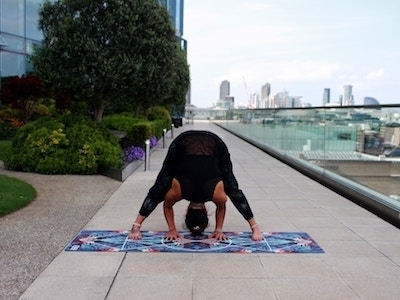A skeptic’s guide to yoga
January 26, 2020

Everyone I know is stressed and pressed for time. It’s so easy to get caught up in the demands of modern life: getting the kids to school, getting that work project done, getting the kitchen cleaned before it needs to be quarantined by your local health department. Here’s the thing: Both your brain and body both need a reprieve from your whirlwind schedules. Whenever my life feels like it’s running me instead of the other way around, I make sure that yoga goes right to the top of my to-do list.
Yoga is the perfect blend of deep breathing and physical movement. It’s equal parts calming and challenging. I’ve been doing yoga regularly for two years. I either squeeze it into my morning schedule or go to my local yoga studio Saturday morning. It’s absolutely critical to keep me centered, healthy and sane. Here’s why I think you should do it too:
Wait, isn’t yoga just fancy stretching?

Nope, it’s so much more than that. It seems like all my friends and fellow fitness enthusiasts discovered yoga in the early aughts, but yoga has a 5,000-year history as a spiritual practice. When it comes to well-being, yoga is an incredibly versatile practice. It incorporates breathing, meditation, and fitness components — like strength, flexibility, and balance — all into one. And it’s great for any level of fitness, because you can make each session your own. You can choose to focus more on your breathing or increase the intensity of your poses and flows. The important part is that you determine the style of your yoga practice.
Does yoga really count as exercise?
Lots of people poo-poo the physical benefits of yoga. I vehemently disagree. Yoga is proven to help improve strength, flexibility, balance and heart health. In 2015, a study dove into the physical benefits of yoga. After just 12 one-hour sessions, led by an experienced yogi once a week, participants showed improved cardiorespiratory fitness and a lower resting heart rate. The yoga group also had more flexibility in their low back and hamstrings. But wait, there’s more! Participants even had better muscle strength and endurance in the abdominals and upper body. And that’s after just twelve sessions! Imagine what could happen if you worked yoga into your regular routine? With more consistent performance of yoga, you can see even more cardiovascular benefit — like lower blood pressure. It may even help reduce inflammation.
Why do yoga instructors keep telling me to breathe?

I get it. You’re breathing already. So, why the constant reminders to breath? Because it’s good for you! Regular exercise helps with your stress levels. Basically, it clears your brain and puts your mind at ease. Yoga amplifies these benefits with deep breathing techniques.
Most of the time, we breathe unconsciously, not thinking about it. During yoga, you focus on getting into a deep breathing rhythm. This slow, yogic breathing can be a huge game changer for your mental health. Brace yourself for a little *science*. Unconscious bodily functions, like breathing, are governed by the autonomic nervous system. This branch breaks down into two major systems: the “fight or flight” system (or sympathetic system) and the “rest and digest” system (or parasympathetic system). As you probably guessed, the physiological responses associated with the “rest and digest” system are generally more pleasant to experience and gentle on your body.
But the pace of our society isn’t conducive to resting and digesting. Running from one thing to another keeps us in the sympathetic state more often than we need to be. Life in the fight or flight zone means our autonomic nervous system is on high alert and ready to spring into action. As a result, your heart rate, blood pressure, and muscular tension all go up.
When you slow your breathing down in yoga, you activate the parasympathetic system, which reduces heart rate, blood pressure, and muscular tension. So, yeah — breathing really is a big deal. And that’s why your yoga instructor won’t stop talking about it. Taking a few moments to slow it down and control your breathing is instrumental for the nervous system, positively impacting respiratory efficiency and cardiovascular function.
Alright — how do I get started?

Since you’re probably already wearing yoga pants (no judgement, me too), getting started should be super easy. If this is your first foray into fitness, yoga can be a very gentle way to put your toe in the water of the exercise world. For exercise fanatics, adding this practice to your workout regimen — even once a week — can improve your performance in other areas of strength, flexibility, and balance. It's a win-win form of exercise!
Look into your local yoga studios or group fitness classes to see if this is something they offer and give it a try! If you’d like a little more one-on-one guidance, try working with a trainer that is familiar with yoga at your gym or book a session with an online personal trainer (like me!). And, thanks to the internet, you can always pull up a Youtube video with tons of different options at your fingertips!
Namaste.